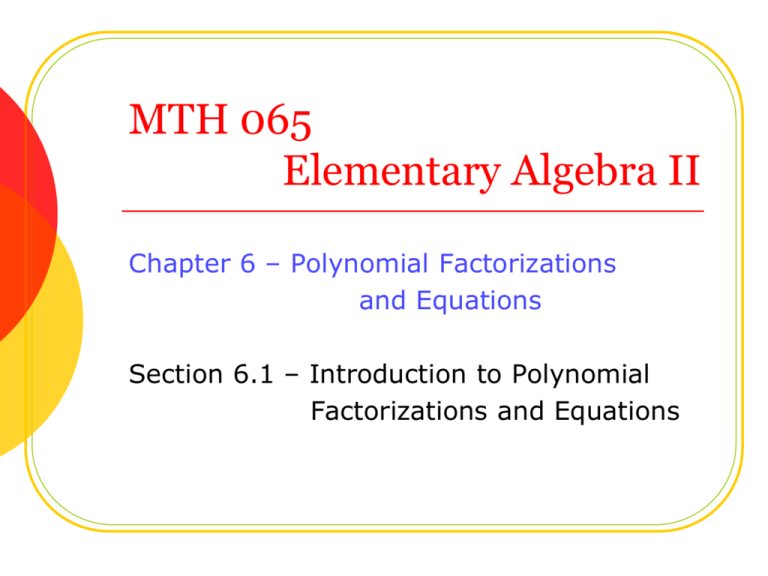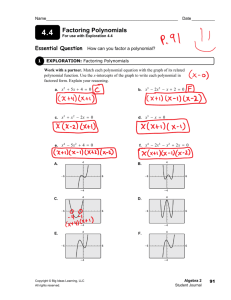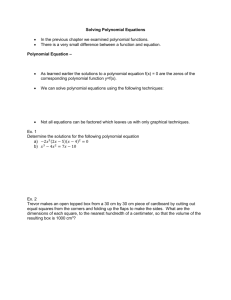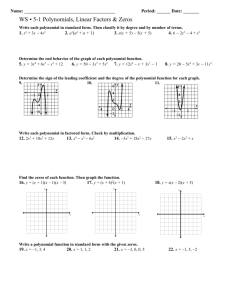MTH 065 Elementary Algebra II
advertisement

MTH 065 Elementary Algebra II Chapter 6 – Polynomial Factorizations and Equations Section 6.1 – Introduction to Polynomial Factorizations and Equations Polynomial Equations Definition Standard Form An equation that states that two polynomials are equal to each other. p(x) = 0 Combine like terms Terms from highest to lowest degree Leading coefficient positive Degree of a Polynomial Equation Degree of the leading coefficient when in standard form. Polynomial Equations Solution Solution Set A value for the variable that makes the equation true. Set of all solutions. Fundamental Theorem of Algebra An nth degree polynomial equation will have at MOST n solutions. Polynomial Equations – Examples 2x – 5 = 13 x2 + 2x = 5x – 2 Standard form: 2x – 18 = 0 Degree 1 (linear) Solution: x = 9 Standard form: x2 – 3x + 2 = 0 Degree 2 (quadratic) Solutions: x = 1, 2 x3 + 3 = 5x – x2 Standard form: x3 + x2 – 5x + 3 = 0 Degree 3 (cubic) Solutions: 1, –3 Graphical Solutions 1. Put the equation in standard form. 2. Graph the function p(x). 3. p(x) = 0 Use a graphics calculator or software. Determine the x-intercepts. Where the graph intersects the x-axis. Values of x where p(x) equals 0. These are the solutions. NOTE: The values of x where p(x) = 0 are called … zeros of p(x) & roots of p(x) = 0 Graphical Solutions – Example 1 2x – 5 = 13 2x – 18 = 0 Solution aka: zeros or roots x=9 Graphical Solutions – Example 2 x2 + 2x = 5x – 2 x2 – 3x + 2 = 0 Solutions aka: zeros or roots x = 1, 2 Graphical Solutions – Example 3 x3 + 3 = 5x – x2 x3 + x2 – 5x + 3 = 0 Solutions aka: zeros or roots x = 1, –3 Factored Polynomials A polynomial written as a product of two or more polynomials. Examples: x2 – 3x + 2 = (x – 1)(x – 2) x3 + x2 – 5x + 3 = (x – 1)2(x + 3) The Principle of Zero Products If ab = 0, then a = 0, b = 0, or both are zero. Examples: If 5x = 0, then x = 0. If 3(x – 1) = 0, then x – 1 = 0 (i.e. x = 1) Solving Factored Polynomial Equations NOTES One side of the equation MUST be zero. The other side must be factored. 1. Set each factor equal to zero. 2. Solve each simpler equation. 3. Solution set is all of the solutions. Solving Factored Polynomial Equations – Example 1 (x – 1)(x – 2) = 0 x–1=0 x=1 x–2=0 x=2 Solutions: x = 1, 2 Solving Factored Polynomial Equations – Example 2 (x – 1)2(x + 3) = 0 x–1=0 x=1 x + 3 = 0 x = –3 Solutions: x = 1, –3 Solving Factored Polynomial Equations – Example 3 7x(3x – 2)(5x + 1) = 0 x=0 3x – 2 = 0 x = 2/3 5x + 1 = 0 x = –1/5 Solutions: x = 0, 2/3, –1/5 Solving Polynomial Equations by Factoring Using the “Principle of Zero Products” p(x) = 0 can be solved … 2. The primary topic of this chapter! Set each factor equal to zero 3. Solve these simpler equations 1. Factor p(x) NOTE: If the equation is not originally in the form p(x) = 0, first determine this equivalent standard form. Factoring – Step 1 Distributive Property ax + ay = a(x + y) ax – ay = a(x – y) Factoring Out Common Factors Common Factors If ALL of the terms of a polynomial have a common factor, that common factor may be “factored out.” Example: 5x2 – 15x = 5x(x – 3) Factoring – Step 1 Note: If the leading coefficient is negative, it is common to factor out the negative. Examples: Common Factors –3x + 21 = –3(x – 7) –x2 + 15x = –x(x – 15) –x3 – 7 = –(x3 + 7) –6x2 – 2x = –2x(3x + 1) Notice that the sign of each term is changed when factoring out a negative. Factoring – Step 2 Factoring by Grouping Note: This method is used with 4-term polynomials. x2 + 5x + 2x + 10 1. Make two groups of two terms. (x2 + 5x) + (2x + 10) 2. Factor out common factors from each pair. x(x + 5) + 2(x + 5) 3. If the remaining polynomials are the same, factor out the polynomial. (x + 5)(x + 2) NOTE: Be careful with negative terms! Clarifying Terminology!!!!! Expressions can be factored. 2x3 – 12x2 = 2x2(x – 6) Equations can be solved. 2x3 – 12x2 = 0 x = 0, 6 Sometimes, an expression in an equation is factored in order to solve the equation. 2x3 – 12x2 = 0 2x2(x – 6) = 0 x = 0 or x – 6 = 0 x = 0, 6







